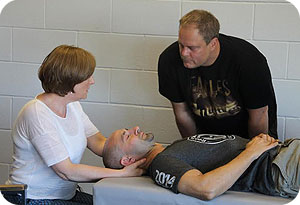I have been reflecting on how boundless and important palpation, is or it can be when we feel totally at ease and comfortable with this this  tool.
tool.
Often we are taught palpation as a tool for information gathering, land-marking are way round the body. I believe we get caught up in what we are ‘needing’ to feel, ‘wanting to get it right’. Missing the subtlety that needs to acquired, so we are able to notice small changes in tissue, this information may make the difference in our treatment approach, or it can be the point where trust is built between therapist and patient, adding towards ultimate success.
We need to ‘rest’ our hands (keeping them soft and gentle) on the patient, learning to listen to their body’s rhythm, being present with the person. Feel for their breath, with clear intent of kindness and compassion we have within ourselves
If we have studied anatomy, we should know where muscles are without always checking where our fingers are with sight, because this can lead to conveying the message that we are unsure in our skills and knowledge.
This first touch/palpation can convey our intent; it can give the message that we are looking and listening. The care for the patient begins in this first moment of contact. If we are too ‘poking’ or ‘jabbing’, the patients’ defences may harden and we gather little or no information.
So it is soft hands, soft knees and an open enquiring humble mind.
